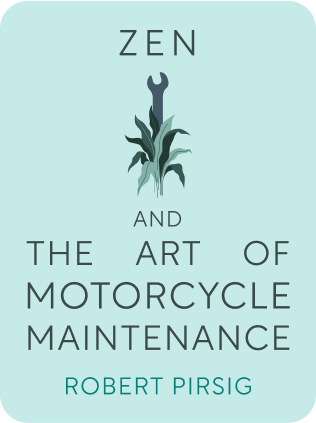

This article is an excerpt from the Shortform book guide to "Zen And The Art Of Motorcycle Maintenance" by Robert Pirsig. Shortform has the world's best summaries and analyses of books you should be reading.
Like this article? Sign up for a free trial here .
What does finding your path mean? How does Zen and the Art of Motorcycle Maintenance explain how to find your path?
In Zen and the Art of Motorcycle Maintenance, finding your path means evaluating your life and what’s ahead to find your own logical path forward. Pirsig uses a journey up a mountain to help explain his views on this concept.
Read more about finding your path in Zen and the Art of Motorcycle Maintenance.
Steps to Finding Your Path
In Zen and the Art of Motorcycle Maintenance, Pirisg offers up the idea that finding your path can be a logical, methodical process. Here are his steps for finding your path.
Chautauqua: Phaedrus’s Inquiry into Quality
Phaedrus saw his inquiry into Quality as an attempt to find a new path up the mountain of existential meaning. His ascent can be divided into two phases: a creative, unsystematic phase, which Phaedrus found enjoyable; and a rigorous, hierarchical phase, which Phaedrus thought resulted in a new conception of human existence but came at the cost of his family and freedom.
Pirsig believes that a new theory of the meaning of existence—a new path up the mountain—is needed now more than ever. Many modern people still follow the precepts of Jesus and Moses, but if those figures were to appear today and start spreading their message, they wouldn’t be taken seriously. This isn’t because their ideas aren’t wise or true, but rather because the historical context has changed—a reference to “Heaven above,” in an age when we can see into distant space, prompts questions about where exactly Heaven is located.
Although Phaedrus believed he’d found a new route up the mountain, Pirsig is less certain, primarily because his knowledge of Phaedrus’s system is incomplete. Pirsig admits that, at first, he hesitated to research Phaedrus’s ideas for fear he would descend into madness as Phaedrus had. But even when he convinced himself he wasn’t in danger, he had to reconstruct Phaedrus’s ideas from scattered notes and fragments of memory. He acknowledges there are errors and ambiguities in his account of Phaedrus’s thought, but he affirms that these are likely a product of Pirsig’s reconstruction rather than the thought itself, and is a step toward finding your path.
Chautauqua: Logic: The Path Through Hierarchies
Once a hierarchy is established, we navigate its levels by virtue of logic. Pirsig notes that logic comes in two forms: inductive and deductive.
Inductive Reasoning
Example: If every time you hit a bump on your motorcycle the engine misfires, but the engine never misfires on level ground, you’re likely to conclude that the bumps are causing the misfires.
Definition: Induction proceeds from specific instances to general conclusions.
Deductive Reasoning
Example: A mechanic, having read a motorcycle’s manual, knows that the cycle’s horn is powered by the motorcycle’s battery. If the horn isn’t functioning, he can infer that there’s something wrong with the battery.
Definition: Deduction proceeds from general knowledge to a particular conclusion.
The scientific method—that is, the procedure for designing experiments to test hypotheses—comprises a mix of inductive and deductive reasoning. Although few motorcycle malfunctions require the full-scale scientific method, some do, and so it pays to be familiar with each of its steps
1. Statement of the Problem
The key here is to approach the problem as specifically as possible without assuming too much in advance. For example, beginning with a question like Why is my cycle malfunctioning? is better than beginning with Why are the valves causing my cycle to malfunction? because, at least at the outset, you may not be sure the valves are the problem.
2. Statement of the Hypothesis
* Here is where you can home in on a specific culprit for the malfunction: “Hypothesis: Valves are causing the malfunction.” You may also include any other hypotheses you want to test.
3. Design of Experiment
In this step, you design a particular experiment (or experiments) that will determine whether the valves are responsible for the malfunction. It’s important to note that the only “failed experiment” is one that doesn’t provide information about a hypothesis. If your experiment proves your hypothesis incorrect—i.e., that the valves aren’t the problem—that’s a successful experiment. If your experiment proves that the valves or several other components could be the cause of the malfunction, then that’s a poorly designed experiment.
4. Predicted Results of Experiment
Your experiment’s predicted results are a kind of check on the design of your experiment. If your predicted results involve valve function, but your experiment produces feedback from the pistons or some other component, then that’s a clue your experimental design was flawed.
5. Observed Results of Experiment
This step is fairly self-explanatory, but make sure to record the results of your experiment, as well as the experiment’s design. If you need to tinker with the experiment to produce further results, you’ll want to have that record to refresh your memory of what you’ve already done.
6 Conclusions from the Results of the Experiment
As with Step #1, the key here is not to draw conclusions unsupported by the experiment’s results. For example, if your original problem was that your motorcycle was malfunctioning, your hypothesis was that the valves were the culprit, and your experiment showed that the valves are indeed faulty, you haven’t necessarily solved your problem. Why not? Because your motorcycle’s malfunction could be caused by multiple factors, only one of which is valve trouble.
As we move through these steps, we’re constantly combining deductive and inductive reasoning. When we design our experiment to test the valves, we might be thinking about the valvetrain system (deductive) or a malfunction in the past when the valves proved to be the issue (induction). When we execute our experiment, we’re using observed results to draw a conclusion (induction); and when we tinker with the experiment to produce new results, we’re drawing on our conceptual knowledge of related components’ functions (deduction).
The story picks up just as Pirsig nearly crashes head-on into a car passing in the opposite lane. The riders stop in a town shortly thereafter for lunch; Sylvia is still shaken up by the incident. Back on the road, Pirsig tells us we’re at the point where he can speak about Phaedrus’s abandonment of rationality in pursuit of the core of rationality itself. Finding your path can also follow these steps, as you pursue what may otherwise not make sense.

———End of Preview———
Like what you just read? Read the rest of the world's best book summary and analysis of Robert Pirsig's "Zen And The Art Of Motorcycle Maintenance" at Shortform .
Here's what you'll find in our full Zen And The Art Of Motorcycle Maintenance summary :
- How an unnamed narrator and his son are on a cross-country motorcycle journey
- Why technology can be creative
- How to focus on what's in front of you in order to get exactly what you need






